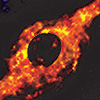| Feb 19, 2024 |
|
|
|
(Nanowerk News) The fastest-growing black hole ever recorded – devouring the equivalent of one sun every day – has been discovered by researchers at The Australian National University (ANU).
|
|
The researchers’ findings are published in Nature Astronomy (“The accretion of a solar mass per day by a 17-billion solar mass black hole”).
|
|
Lead author Associate Professor Christian Wolf from ANU said it’s a record he doesn’t think will ever be beaten.
|
|
“The incredible rate of growth also means a huge release of light and heat,” Associate Professor Wolf said. “So, this is also the most luminous known object in the universe. It’s 200 trillion times brighter than our sun.”
|
|
Co-author Dr Christopher Onken added: “It’s a surprise it remained undetected until now, given what we know about many other, less impressive black holes. It was hiding in plain sight.”
|
 |
| Artistic rendering of the monster black hole. (Image: Cristy Roberts, ANU)
|
|
The black hole has a mass roughly 17 billion times that of our solar system’s sun.
|
|
It was first detected using a 2.3 metre telescope at the ANU Siding Spring Observatory near Coonabarabran in NSW. The research team then turned to one of the largest telescopes in the world – the European Southern Observatory’s Very Large Telescope – to confirm the full nature of the black hole and measure its mass.
|
|
“The light from this black hole has travelled over 12 billion years to reach us,” Professor Rachel Webster from the University of Melbourne said.
|
|
“In the adolescent universe, matter was moving chaotically and feeding hungry black holes. Today, stars are moving orderly at safe distances and only rarely plunge into black holes.”
|
|
The intense radiation comes from the accretion disc around the black hole, which is the holding pattern for all the material waiting to be devoured.
|
|
“It looks like a gigantic and magnetic storm cell with temperatures of 10,000 degrees Celsius, lightning everywhere and winds blowing so fast they would go around Earth in a second,” Associate Professor Wolf said.
|
|
“This storm cell is seven light years across, which is 50 per cent more than the distance from our solar system to the next star in the Galaxy, alpha Centauri.
|
|
“We were only able to make these discoveries because of The Australian Government’s 10-year partnership with the European Southern Observatory (ESO).”
|
|
The research was done in collaboration with the ESO, University of Melbourne and the Sorbonne Université in France.
|


